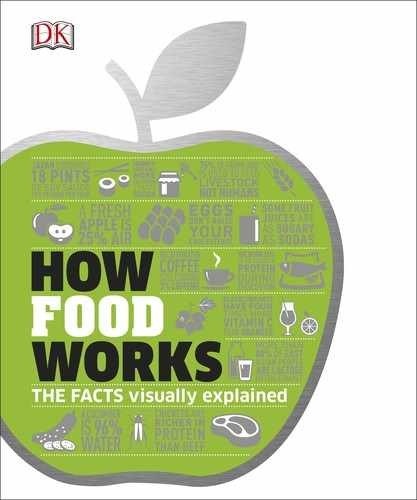
STORING AND COOKING
Preservation
Preservation
The very things that make food nutritious
also make it vulnerable to contamination
and degradation, so preserving food has
always been a key concern of food science
and cultures since ancient times.
Types of preservation
Natural processes, including
microbial growth, oxidation,
heat and light, and the action of
enzymes can contaminate foods
or degrade them by breaking down
their key components. The rate
of the biochemical reactions that
drive these processes depends on
favorable conditions, so altering
these in different ways can help to
preserve foods. Some preservation
methods, such as drying, have
been used for tens of thousands
of years. Artificial chemical
preservatives are common
today—but their implications
for our health remain uncertain.
Chilling and freezing
Reducing temperature
decreases the rate of
biochemical reactions.
Freezing suspends them.
Drying
Water is necessary for most
biochemical activity, so
removing moisture can
prevent microbial growth.
Salting
Increasing the concentration
of salts in food kills most
microbes by dehydrating
them.
Pickling
Making food more acidic
can kill many microbes but
will also affect the food’s
taste and characteristics.
Smoking
Smoking infuses foods with
a variety of antimicrobial,
antioxidant, and acidifying
compounds.
Chemical
Artificial preservative
chemicals, such as nitrates,
are commonly used in foods
such as meats (see pp.74–75).
Canning
In addition to sealing food,
canning also involves
extreme heat treatment
to kill off any microbes.
How nutrients degrade
Some categories of nutrients, such
as vitamins and antioxidants, are
reactive since they are composed of
fragile molecules. Such vulnerable
molecules will degrade naturally
over time, a process that speeds up
greatly with heat, physical damage,
exposure to sunlight, and exposure
to oxygen– the last of which
generates destructive free radicals
(see p.111). Different nutrients are
more sensitive to certain threats
than others.
SPICES AND HERBS
WERE USED AS
PRESERVATIVES BY
ANCIENT CIVILIZATIONS
Storing
Storing food in cool, dark
conditions prolongs its shelf life,
as will reducing exposure to
oxygen and ambient microbes.
NUTRIENT NUTRIENTLEVEL OF STABILITY LEVEL OF STABILITY
Relatively stable
Highly unstable; sensitive
to air, light, and heat
Can become rancid
(see p.74), particularly
at higher temperatures
Sensitive to light and heat
Sensitive to air, light,
and heat
Relatively stable
Highly unstable; sensitive
to air, light, and heat
Highly unstable; sensitive
to air, light, and heat
Somewhat sensitive
to air, light, and heat
Sensitive to air, light,
and heat
Proteins,
carbohydrates
Vitamin B1
(thiamine)
Fat
Vitamin B2
(riboflavin)
Vitamin A
Vitamins
B3 (niacin),
B7 (biotin)
Vitamin C
Vitamin B9
(folic acid)
Vitamin D Carotenes
US_048-049_Preservation.indd 48 18/01/2017 09:42
48 49
STORING AND COOKING
Preservation
Preservation in action
Different preservation methods work in
differing but often complementary ways.
Each strategy guards against some or most
of the threats, though few can protect
against all of them. Pasteurization (heating
food to destroy harmful microbes) is a safety
measure that also preserves food.
HOW LONG CAN
TINNED FOOD LAST?
In theory, canned food should
last indefinitely. In 1974, cans
recovered from the Bertrand,
a steamer that sank in the
Missouri River in 1865, were
found to be edible.
Sunlight
Oxidation
Enzymes
Microbes/
bacteria
Slowed
C
H
I
L
L
I
N
G
C
H
E
M
I
C
A
L
P
R
E
S
E
R
V
A
T
I
V
E
S
S
A
L
T
I
N
G
A
N
D
S
M
O
K
I
N
G
P
I
C
K
L
I
N
G
D
R
Y
I
N
G
C
A
N
N
I
N
G
S
T
O
R
I
N
G
(
A
i
r
t
i
g
h
t
c
o
n
t
a
i
n
e
r
,
k
e
p
t
i
n
d
a
r
k
n
e
s
s
)
P
A
S
T
E
U
R
I
Z
I
N
G
F
R
E
E
Z
I
N
G
Stopped
KEY
FOOD
US_048-049_Preservation.indd 49 18/01/2017 09:42

48 49
STORING AND COOKING
Preservation
Preservation in action
Different preservation methods work in
differing but often complementary ways.
Each strategy guards against some or most
of the threats, though few can protect
against all of them. Pasteurization (heating
food to destroy harmful microbes) is a safety
measure that also preserves food.
HOW LONG CAN
TINNED FOOD LAST?
In theory, canned food should
last indefinitely. In 1974, cans
recovered from the Bertrand,
a steamer that sank in the
Missouri River in 1865, were
found to be edible.
Sunlight
Oxidation
Enzymes
Microbes/
bacteria
Slowed
C
H
I
L
L
I
N
G
C
H
E
M
I
C
A
L
P
R
E
S
E
R
V
A
T
I
V
E
S
S
A
L
T
I
N
G
A
N
D
S
M
O
K
I
N
G
P
I
C
K
L
I
N
G
D
R
Y
I
N
G
C
A
N
N
I
N
G
S
T
O
R
I
N
G
(
A
i
r
t
i
g
h
t
c
o
n
t
a
i
n
e
r
,
k
e
p
t
i
n
d
a
r
k
n
e
s
s
)
P
A
S
T
E
U
R
I
Z
I
N
G
F
R
E
E
Z
I
N
G
Stopped
KEY
FOOD
US_048-049_Preservation.indd 49 18/01/2017 09:42
..................Content has been hidden....................
You can't read the all page of ebook, please click here login for view all page.
